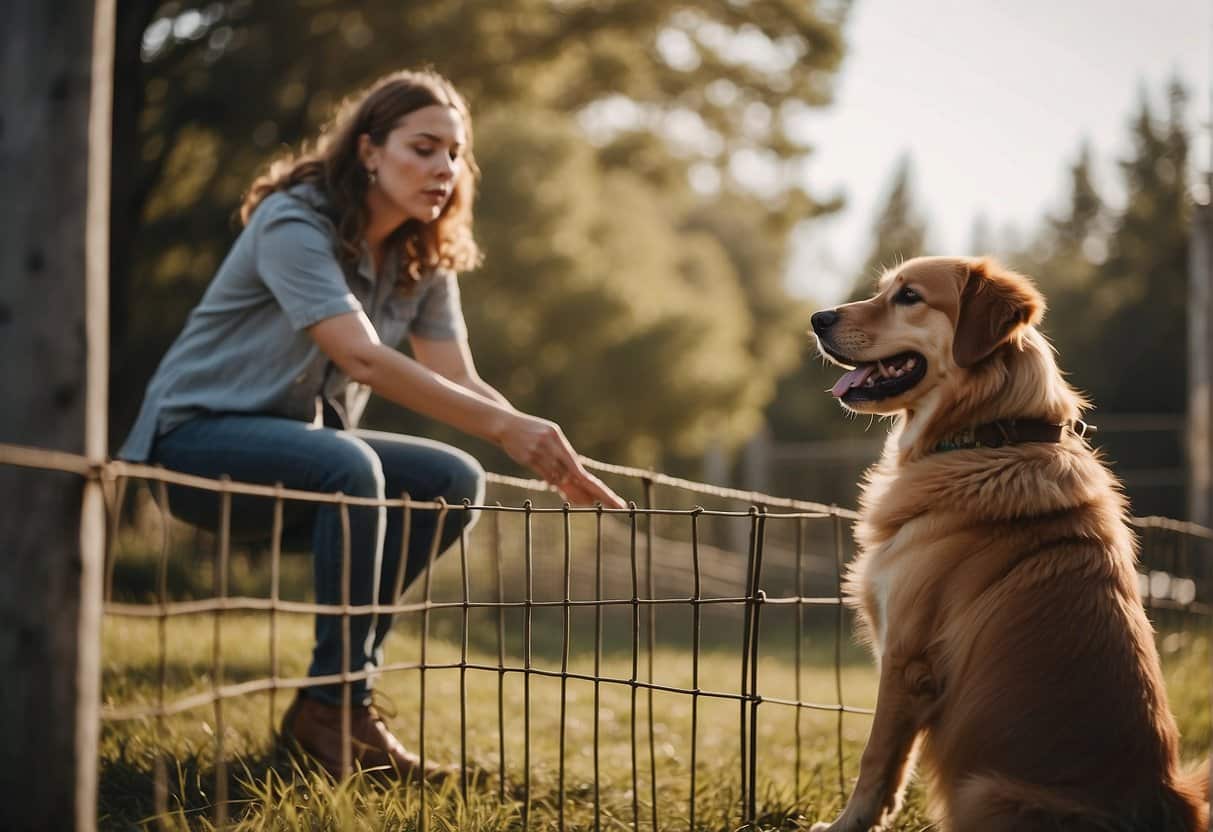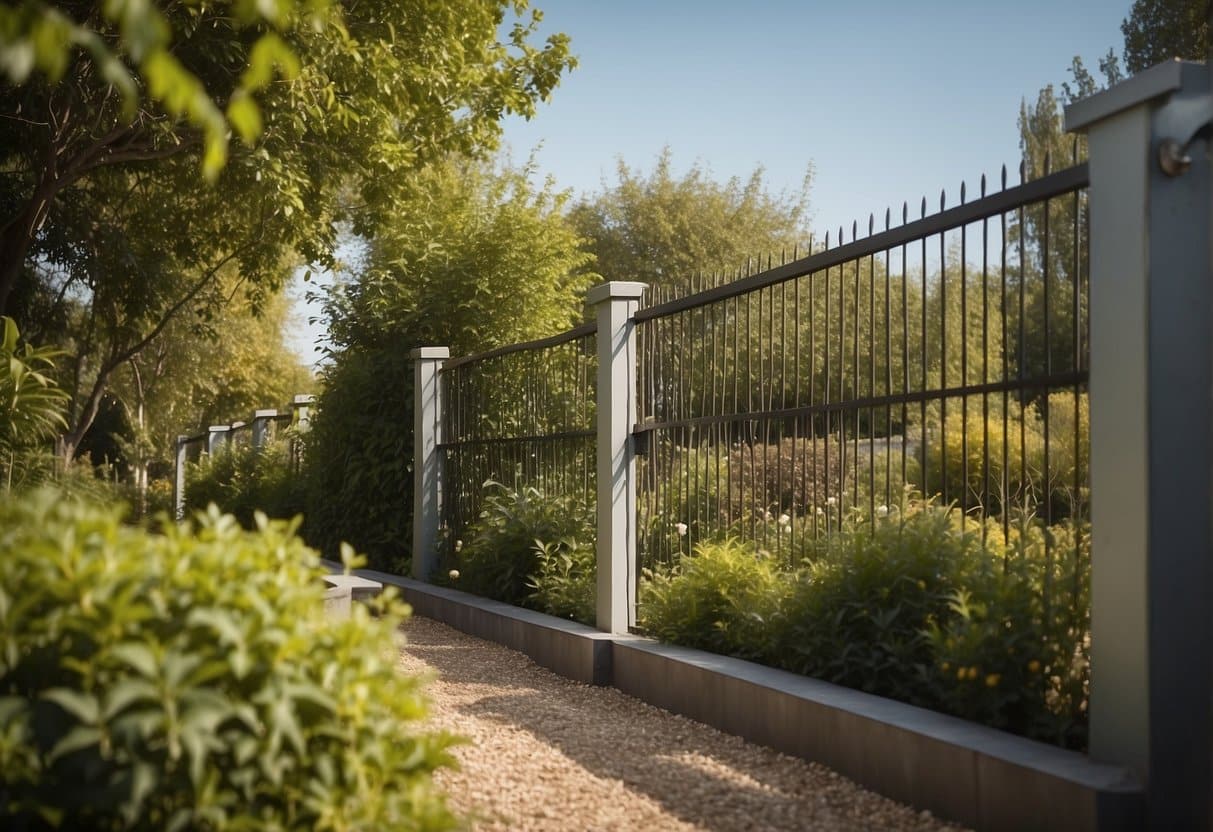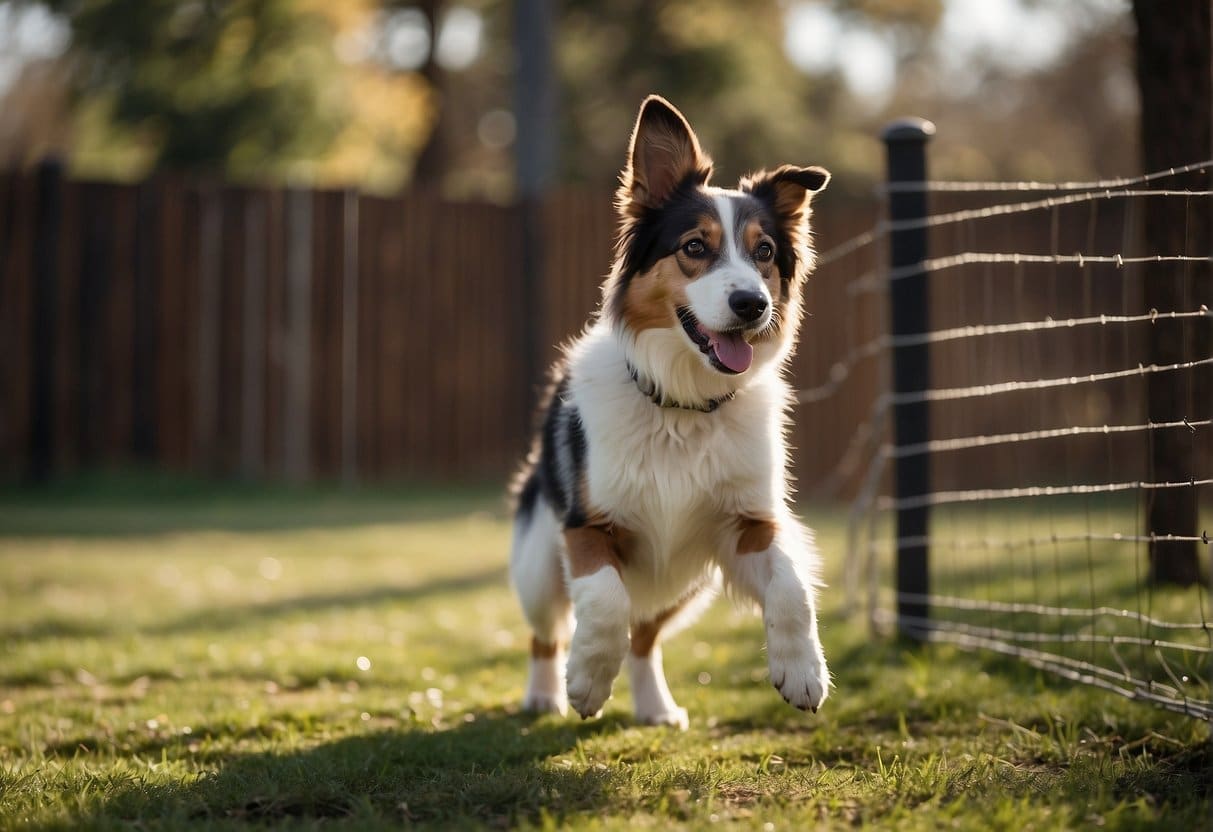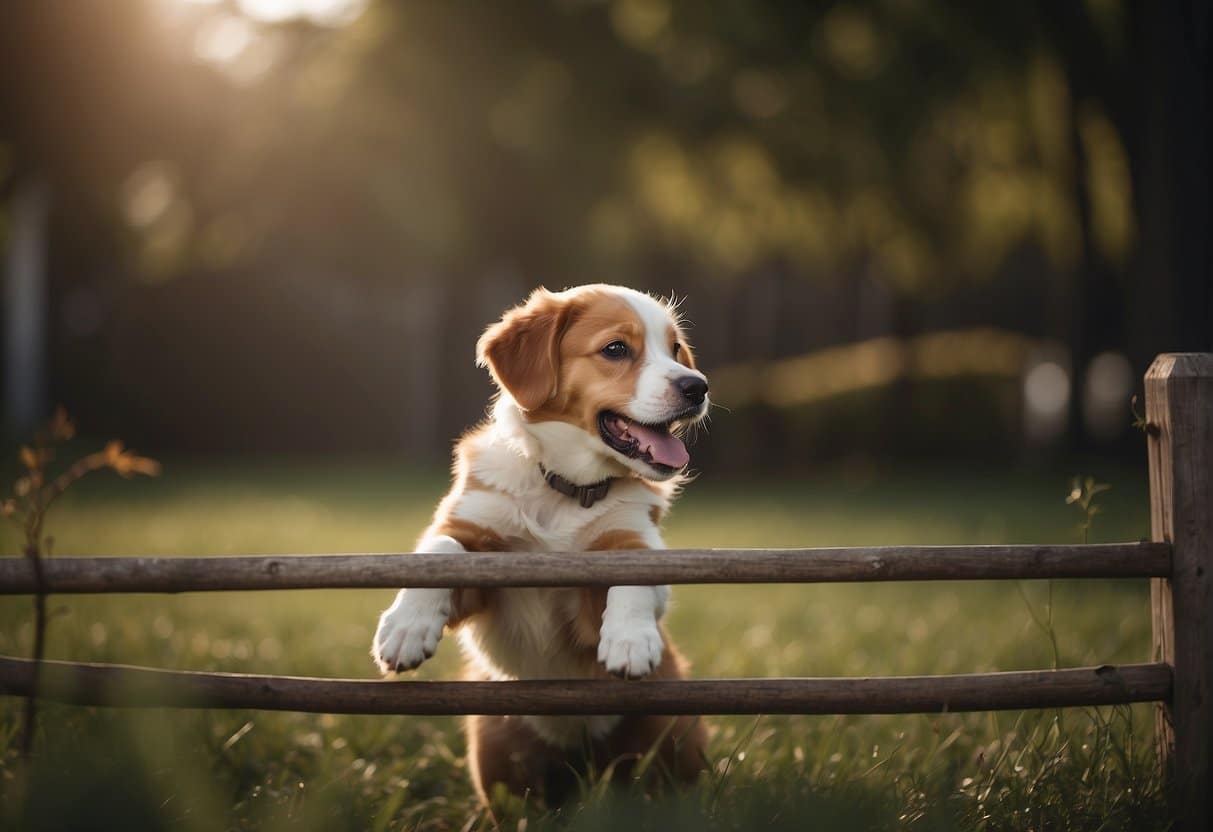
Dog owners often face the challenge of keeping their pets safely contained within their yards. Dogs may attempt to climb over fences for a variety of reasons, such as curiosity, seeking attention, or pursuing something they find interesting on the other side. Ensuring that your furry friend stays in your yard is important for their safety and your peace of mind. A combination of training and physical barriers can effectively prevent your dog from climbing fences.
Certain enhancements to your existing fence can make it more difficult for your dog to escape. For instance, installing rollers or angled extensions can deter your dog from getting the grip they need to hoist themselves over. It’s also crucial to provide a stimulating environment for your dog. A yard with plenty of toys and interactive features can keep your dog entertained and less likely to look for escapades outside the confines of their home.
Key Takeaways
- Training and barriers can successfully keep dogs within the yard.
- Modifying your fence can prevent dogs from gripping and climbing.
- A stimulating yard reduces your dog’s desire to escape.
Understanding Your Dog’s Behavior

Before attempting to prevent your dog from climbing the fence, it’s crucial to understand why they may exhibit this behavior. It often relates to the breed’s inherent traits and their need for adequate exercise and mental stimulation.
Breed Characteristics
Energy Levels: Different breeds possess varying energy levels. Energetic breeds like the Border Collie may have a natural propensity for climbing or jumping over fences due to their high levels of vigor and agility.
- Tendency to Roam: Some dogs, particularly those with strong hunting instincts, might attempt to climb fences when they catch the scent of prey or wish to explore beyond their immediate surroundings.
Exercise and Stimulation
Exercise Requirements: To mitigate fence-climbing behaviors, ensure your dog is receiving enough physical exercise. A tired dog has less energy to put towards attempts at escaping.
- Daily Routines: Integrate daily walks, runs, or games of fetch to help spend your dog’s energy in a positive way.
Mental Engagement: Boredom can lead to unwanted behavior like fence climbing. Incorporating mental stimulation into your dog’s routine is as important as physical exercise.
- Puzzle toys or training sessions can provide mental challenges that keep your dog engaged and less inclined to seek entertainment by escaping.
By understanding the role that breed characteristics and the need for exercise and stimulation play in your dog’s behavior, you can create an environment that both fulfills them and deters fence climbing.
Effective Dog Training Techniques
Mastering effective dog training techniques is essential for keeping your dog from climbing fences. By focusing on commands and positive reinforcement, as well as the importance of socialization, you can dramatically improve your dog’s behavior and create a secure environment.
Commands and Positive Reinforcement
Teaching your dog basic commands like “sit,” “stay,” and “come” is the foundation of good behavior. You should practice these commands consistently, using positive reinforcement as a key element. Reward your dog’s compliance with treats or praise to encourage the desired behavior.
- Sit: When they sit on command, offer a treat and verbal praise.
- Stay: Build duration gradually, rewarding your dog for staying put even with distractions.
- Come: Use an enthusiastic tone and treat rewards to reinforce this vital recall command.
Incorporate games that reinforce these commands, such as hide and seek which emphasizes “come,” or red light, green light for “sit” and “stay.”
Socialization
Proper socialization involves exposing your dog to a variety of environments, people, and other animals in a controlled way. This exposure helps prevent anxiety and restlessness that might lead to fence climbing.
- Schedule regular playdates with other dogs.
- Visit different places to expose your dog to various stimuli.
- Always monitor your dog’s body language to ensure comfort and safety during socialization activities.
Through consistent command training and comprehensive socialization, your dog should not only understand but also adhere to the boundaries you’ve set, reducing the likelihood of fence-related incidents.
Choosing the Right Fence

When securing your yard to prevent your dog from climbing over the fence, it’s crucial to consider both the materials and the design of the fence, along with its height and depth, to ensure it meets your needs effectively.
Materials and Design
The type of material and design of your fence can play a significant role in its effectiveness. Chain link fences are durable and see-through, which helps in keeping an eye on your pet, but they can be easy for dogs to climb. To enhance a chain link fence, consider adding PVC pipe rollers at the top which prevent your dog from getting a good grip.
For a more aesthetic and climb-resistant option, a wooden fence provides a solid barrier that lacks footholds, making it harder for dogs to scale. You can install bamboo slats to a wooden fence to increase privacy and reduce visual stimuli that may entice your dog to jump over.
If visibility and air flow are important to you, you might opt for a design that includes horizontal slats with limited spacing. Yet, make sure these slats do not provide your dog with footholds to climb.
Using chicken wire at the bottom part of any fence can help deter digging and climbing, as its flexible nature is difficult for dogs to navigate.
Height and Depth
Your fence’s height is pivotal in preventing your dog from jumping over it. A fence should ideally be at least 6 feet tall to prevent most dogs from leaping over. However, for breeds known for their agility, you may need an even taller barrier.
Depth is equally important to prevent your dog from escaping underneath. For diggers, you can dig a 1-foot trench along the fence’s perimeter and use chicken wire or hardware cloth, bent in an L-shape and buried to create a dig-proof barrier.
Enhancing Fence Security
To effectively keep your dogs from climbing the fence, it’s important to enhance your fence in ways that focus on safety and discourage escape attempts. This section will cover practical measures you can implement.
Obstacles and Barriers
Creating Physical Barriers
- Install an L-footer: An L-footer can be a deterrent for dogs who dig. Simply bend a section of wire fencing into an L shape and secure it at the base of your fence, with one leg of the L extending into your yard.
- Coyote rollers: Install coyote rollers on top of the fence, which prevents your dog from getting the grip they need to pull themselves over.
Utilizing Nature
- Plant dense shrubs: Not only do dense shrubs add beauty to your yard, but they also act as a natural barrier, making it harder for your dog to reach the fence.
Visibility and Distractions
Reducing Temptation
- Block the view: If your dog doesn’t see distractions beyond the fence, they’re less likely to try to climb over. Use solid panels or privacy slats to obscure their view.
Enrichment in Your Yard
- Outdoor bed: Providing an outdoor bed will give your dog a comfortable place to rest and less reason to explore the other side of the fence.
- Second fence: Adding a second fence a few feet inside your main fence can create a buffer zone, making it more challenging for your dog to get close enough to the outer fence to climb.
Maintaining a Safe and Engaging Environment

Creating a secure area for your dog involves more than just putting up barriers. It’s about enriching your dog’s life with entertainment and regular habits that keep them content and grounded within their home space.
Toys and Activities
To ensure your dog’s safety and prevent them from seeking fun elsewhere, provide a variety of toys that cater to their instinctual needs. For example, chew toys for teething puppies or treat-dispensing toys for mental stimulation suit different age groups and can keep your dog engaged for hours.
- Puzzle Toys: Ideal for mental stimulation.
- Chew Toys: Great for teething puppies.
- Tug-of-War Toys: Provide physical exercise and bonding.
Regular Routine
Stability in your dog’s life comes from a regular routine of walks, playtime, and training. Consistent daily walks not only offer exercise but also reinforce the boundaries of their territory. Ensuring your dog is neutered can reduce the urge to roam, providing a safer home environment.
- Morning Walk: Start the day with a brisk walk.
- Training Sessions: Incorporate obedience training into daily activities.
- Evening Playtime: Wind down with a game of fetch.
Neighborly Considerations
Maintaining good relationships with your neighbors is essential. Ensure your dog respects the boundaries of neighboring properties, which can prevent fence climbing tendencies. Communicating with neighbors about your dog’s behavior and boundaries can lead to a safer community for everyone.
- Boundary Training: Teach your dog the edges of their territory.
- Communication: Discuss with neighbors to keep an eye out for any unusual behavior.
Frequently Asked Questions

Effective strategies for containing your dog can range from simple modifications to more intricate solutions, ensuring your pet’s safety and providing you with peace of mind.
What are some inexpensive methods to prevent dogs from jumping over fences?
Inexpensive methods to prevent your dog from fence jumping include basic obedience training to enforce commands like “sit” and “stay,” as well as installing angled fence extensions that make it more difficult for dogs to get a foothold.
Can you provide do-it-yourself solutions to prevent dogs from climbing over fences?
DIY solutions often involve creative deterrents like adding PVC pipe rollers or coyote rollers atop your fence, which spin when your dog tries to grip, causing them to slide off safely back to the ground.
What modifications can I make to a 6ft fence to keep my dog from jumping over it?
For a 6ft fence, consider adding height with extensions or installing a lean-in or lean-over system, which can include a section of fencing angling inwards at the top, making it more challenging for your dog to climb over.
How can I modify a chain link fence to stop my dog from climbing it?
To secure a chain link fence and stop your dog from climbing, secure privacy slats or rolls of bamboo to the links – this decreases visibility and the fence’s climbability by removing footholds.
What deterrents can I add to my fence to discourage my dog from escaping?
Adding deterrents such as coyote rollers, safe anti-climb spikes, or even planting dense, thorny bushes along the fence line can be effective in discouraging your dog from attempting to climb or jump over the fence.
How can you dog-proof an existing fence to prevent a dog from escaping the yard?
Dog-proofing an existing fence can be achieved by ensuring there are no gaps or weak points, possibly by adding a wire mesh or lattice, and by implementing an L-footer along the bottom to prevent digging if your dog is a digger.




